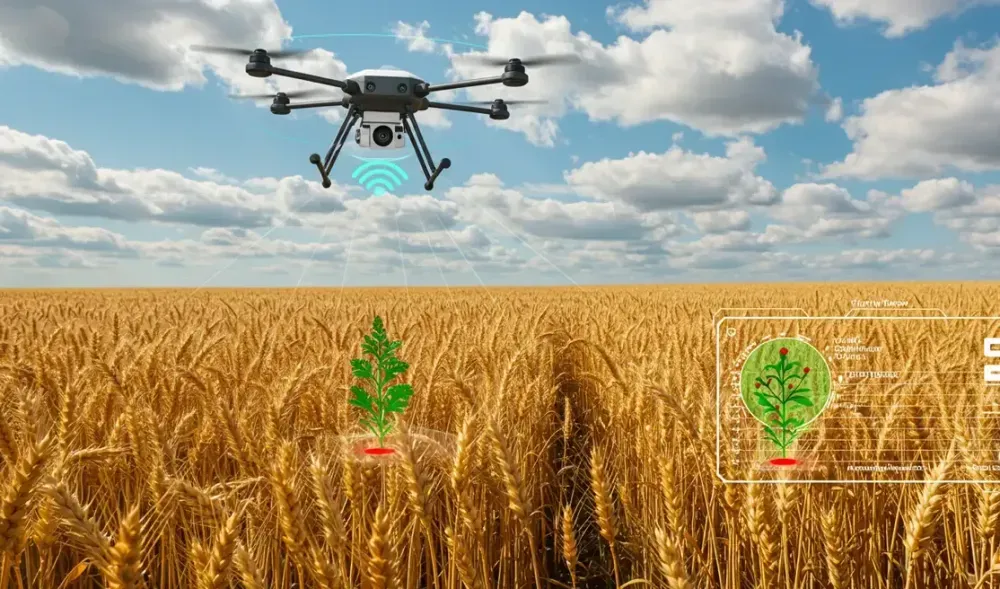Weed Management in Wheat - Cultural, Mechanical, and AI-Driven Synergies

Weed management is a major challenge in wheat production because weeds compete with crops for vital resources such as water, sunlight and nutrients. This competition can significantly reduce crop yields, impacting both food security and economic stability. Traditional weed control methods, while effective, are often labor-intensive, costly, and harmful to the environment, creating a need for more efficient and sustainable solutions.
Sairone, an AI-driven platform developed by Saiwa, is helping to address this challenge. Using drones and advanced machine learning algorithms, Sairone detects weeds early and enables precise herbicide application. This targeted approach minimizes chemical use, cuts costs, and reduces environmental impact, giving farmers a smarter and more sustainable way to manage weeds.
In this article, we'll explore the different weed management strategies used in wheat production, looking at both traditional techniques and the role of emerging technologies such as AI in helping growers improve efficiency and sustainability.
Common Weeds in Wheat Fields
Wheat fields are susceptible to a diverse range of weed species, each presenting unique challenges for management. Accurate identification is the first step towards effective control.
Barnyardgrass (Echinochloa crus-galli)
This annual grass thrives in moist environments and competes aggressively with wheat for resources, particularly nitrogen and water. Its rapid growth and prolific seed production, often exceeding thousands of seeds per plant, make it a formidable adversary.
Control strategies include pre-emergence herbicides applied before barnyard grass germination and cultural practices like delayed planting to reduce early-season competition. Proper seedbed preparation can also help minimize barnyard grass establishment.
Canada thistle (Cirsium arvense)
A persistent perennial weed, Canada thistle spreads through both seeds dispersed by wind and an extensive, deep root system that can regenerate from fragments. Its deep roots, reaching several feet into the soil, make it difficult to control through tillage alone.
Integrated approaches combining herbicide application with cultural and mechanical methods, such as repeated mowing or cutting, are often necessary to exhaust the root reserves.
Horsetail (Equisetum arvense)
This deep-rooted perennial weed is particularly challenging to control due to its extensive rhizome system, which allows for rapid spread and regrowth. Herbicides targeting horsetail are available, but repeated applications may be required for effective control due to the plant's ability to regenerate from rhizome fragments. Understanding the specific horsetail species present is crucial for selecting the most effective herbicide.
Kochia (Kochia scoparia)
A rapidly growing annual weed, kochia exhibits increasing herbicide resistance, posing a significant threat to wheat production, especially in dryland farming systems. Diversifying herbicide modes of action and integrating non-chemical control methods, such as crop rotation and competitive wheat varieties, are essential for managing kochia. Early detection and timely intervention are crucial for preventing kochia from setting seed.
Foxtail millet (Setaria spp.)
Several foxtail species, including green foxtail and yellow foxtail, infest wheat fields, competing for resources and reducing yields by intercepting sunlight and nutrients. Pre-emergence and post-emergence herbicides are effective control options, targeting foxtail seedlings and mature plants, respectively. Cultural practices like crop rotation can also help suppress foxtail populations by disrupting their life cycle.

Advanced Technologies in Weed Management
Technological advancements are transforming weed management, offering unprecedented precision and efficiency.
Automated detection (drones, sensors)
Drones equipped with multispectral and hyperspectral cameras can identify and map weed infestations, providing valuable data for targeted control by differentiating the spectral signatures of weeds and crops.
Sensors placed within the field can monitor weed growth and environmental conditions, including soil moisture and temperature, enabling real-time decision-making for timely interventions. This data can be integrated into farm management software for optimized herbicide application.
AI and machine learning for weed ID
AI algorithms can analyze images and data from drones and sensors to accurately identify weed species, even at early growth stages, by recognizing patterns and features that distinguish them from wheat plants.
This enables precise herbicide application, reducing chemical use and minimizing environmental impact by avoiding blanket spraying. Machine learning models continuously improve their accuracy with increasing data input.
Robotic weed control
Robotic platforms equipped with weeding tools, such as precision sprayers or mechanical weeding implements, can autonomously navigate fields, mechanically removing weeds or applying herbicides with pinpoint accuracy.
This reduces labor costs and minimizes the risk of herbicide drift by targeting individual weeds. These robots can be programmed to adapt to varying field conditions and weed densities.

Cultural Control Practices
Cultural practices manipulate the growing environment to favor wheat growth and suppress weed development.
Crop rotation
Rotating wheat with non-host crops, such as broadleaf crops like soybeans or pulses, disrupts weed life cycles and reduces weed pressure by preventing the buildup of weed seed banks specific to wheat.
This can also improve soil health by increasing organic matter and nutrient cycling, and reduce the risk of herbicide resistance by minimizing selection pressure for resistant weed biotypes. Integrating cover crops into the rotation can further suppress weeds and enhance soil health.
Competitive wheat varieties
Selecting wheat varieties with rapid growth, high tillering capacity, and high canopy closure can outcompete weeds for resources like sunlight, water, and nutrients, reducing the need for chemical control.
Characteristics like leaf angle and height also contribute to a wheat variety's competitiveness. Choosing locally adapted varieties ensures optimal performance under specific environmental conditions.
Seeding rate and date
Optimizing seeding rate and timing can give wheat a competitive advantage over weeds. Higher seeding rates can create a denser canopy, suppressing weed growth by limiting light availability.
Adjusting planting dates to coincide with optimal wheat growth while minimizing weed emergence can further enhance wheat's competitive edge. Seed depth also plays a role in ensuring successful wheat establishment and early vigor.
Nutrient management
Providing adequate nutrients to wheat, particularly nitrogen, promotes vigorous growth and enhances its ability to compete with weeds.
Conducting soil tests to determine nutrient deficiencies and applying fertilizers based on crop needs ensures efficient nutrient utilization and minimizes nutrient availability for weeds. Timing nutrient applications to coincide with critical wheat growth stages maximizes nutrient uptake by the crop.
Mechanical and Physical Methods
Mechanical and physical methods offer non-chemical options for weed control.
Tillage practices
Tillage can effectively control weeds before planting by disrupting weed seedlings and burying weed seeds. However, excessive tillage can disrupt soil structure, increase erosion risk, and deplete soil organic matter.
Conservation tillage practices, such as no-till or strip-till, can minimize these negative impacts while still providing some weed control benefits. Choosing appropriate tillage implements and adjusting tillage depth are crucial for minimizing soil disturbance.
Stubble and residue management
Managing crop residue, including the stubble left after harvest, can suppress weed emergence by reducing light penetration to the soil surface and altering soil temperature, creating less favorable conditions for weed germination.
Residue retention also improves soil health and reduces erosion. However, excessive residue can interfere with planting operations and may harbor certain weed species or diseases.
Mulching
Applying organic mulch, such as straw or wood chips, or synthetic mulch, such as plastic sheeting, can effectively suppress weed growth by blocking sunlight and reducing soil temperature.
Mulching also conserves soil moisture and improves soil health. However, the cost and availability of mulch materials can be limiting factors, and some mulch types may decompose quickly, requiring reapplication.
Chemical Weed Control
Herbicides remain an important tool for weed management in wheat.
Herbicide categories: pre-plant, pre-emergence, post-emergence
Pre-plant herbicides are applied before planting to control existing weeds and provide residual control. Pre-emergence herbicides are applied after planting but before weed emergence, creating a chemical barrier in the soil that prevents weed seedlings from establishing.
Post-emergence herbicides target actively growing weeds, often utilizing specific modes of action to disrupt weed growth processes. Choosing the appropriate herbicide category depends on the weed species present, the timing of application, and the growth stage of the wheat crop.
Best timing for herbicide applications
The optimal timing for herbicide application depends on the weed species, herbicide mode of action, and growth stage of the wheat crop.
Applying herbicides at the correct growth stage of both the weed and the crop maximizes efficacy and minimizes crop injury. Environmental conditions, such as temperature and rainfall, can also influence herbicide effectiveness.
Managing herbicide resistance through rotation and combinations
Rotating herbicide modes of action and using herbicide combinations with different target sites can prevent or delay the development of herbicide resistance in weeds.
This strategy reduces selection pressure for resistant biotypes and ensures long-term weed control efficacy. Monitoring weed populations for resistance development is crucial for adapting herbicide strategies.
Integrated Weed Management Approach

IWM combines multiple weed control methods, including cultural, mechanical, chemical, and biological approaches, to achieve optimal and sustainable weed suppression.
This approach considers the specific weed spectrum, environmental conditions, economic factors, and long-term sustainability goals to develop a tailored management plan for each field. IWM aims to minimize reliance on any single method, reducing the risk of herbicide resistance and promoting a more balanced ecosystem.
Regional Case Studies and Guidelines
Weed management practices vary across different regions due to variations in climate, soil conditions, and weed species.
Practices tailored to Canadian, U.S. Midwest, and European systems
Canadian prairie provinces often face challenges with wild oats and other grass weeds due to the prevalence of cereal crop production. This necessitates the use of selective herbicides and cultural practices like crop rotation to manage these specific weed pressures.
The U.S. Midwest grapples with herbicide-resistant weeds like waterhemp and Palmer amaranth, driven by intensive soybean and corn production, requiring diversified herbicide programs and integrated weed management strategies.
European systems often emphasize cultural and mechanical control methods due to stricter regulations on herbicide use and greater emphasis on environmental stewardship. These practices include crop rotation, cover cropping, and mechanical weeding.
Local extension service recommendations (e.g., Manitoba, MSU, NDSU)
Local extension services, such as Manitoba Agriculture, Michigan State University Extension (MSU), and North Dakota State University Extension (NDSU), provide valuable resources and guidelines for weed management tailored to specific regions.
These resources offer up-to-date information on herbicide efficacy, including local weed resistance patterns, best management practices for specific weed species and cropping systems, and emerging technologies for weed detection and control.
Extension services also conduct field trials and demonstrations to evaluate the effectiveness of different weed management strategies under local conditions. They play a crucial role in disseminating information and providing technical assistance to farmers.
Conclusion
Weed management in wheat requires a balanced approach that combines time-tested practices with the latest technologies. By applying the principles of Integrated Weed Management (IWM) principles, growers can effectively control weeds while reducing their environmental impact. Each part of the strategy plays a critical role in ensuring success, from accurately identifying weeds to using the right mix of herbicides, cultural practices, and mechanical methods.
As the challenges of weed management evolve, it is important to stay up to date with the latest research and local recommendations. The future of weed management looks even brighter as advances in AI and robotics provide more precise and efficient solutions. These innovations will help growers increase yields, improve crop quality,y and make wheat farming more sustainable, ensuring a resilient agricultural system for years to come.
Note: Some visuals on this blog post were generated using AI tools.
